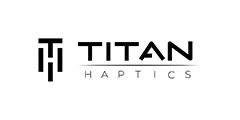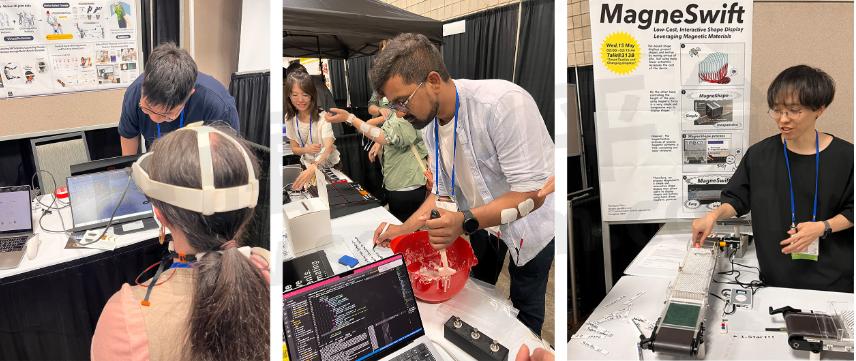Immersive Insights: Exploring the Future of Haptics at the CHI Conference 2024


The field of Human-Computer Interaction (HCI) plays a vital role in shaping our digital experiences, influencing areas that range from the creation of Deepfakes to the development of intuitive chatbots and AI companions.These innovations in HCI are fundamentally transforming our methods of communication, work, learning, and leisure, driving a profound shift in how we interact with technology on a daily basis.
Where can we explore and discuss these captivating trends and crucial issues in Human-Computer Interaction? The answer lies in the annual ACM Conference on Human Factors in Computing Systems (CHI). This year, the conference was held in the picturesque city of Honolulu, Hawaii, and encompassed a broad spectrum of topics – from gaming to mental, physical, and digital health, to the ethics of AI. Haptics, in particular, was a focal point in numerous sessions, underscoring its growing prominence in the realm of HCI.
Here’s a summary of some of the talks, workshops, and awards from the event:
Haptic Workshops
One of the standout sessions was a workshop titled “Haptic Playground: Empowering Inclusive Haptic Design for Everyone.” The workshop, which included his team from USC, UBC, and the University of Waterloo, offered an engaging and hands-on exploration of haptic technology. Esteemed speakers such as Karon Maclean, Oliver Schneider, Allison Okamura, and Heather Culbertson delivered keynote presentations, sharing their insights and latest research in the field.
Other notable workshops include “Novel Approaches for Understanding and Mitigating Emerging New Harms in Immersive and Embodied Virtual Spaces”, which explores new harms on online and virtual spaces and what new technologies and mechanisms can be implemented to mitigate them, and “PhysioCHI: Towards Best Practices for Integrating Physiological Signals in HCI”, which discusses best practices for embedding physiological signals in interactive system.
Haptic Research Papers & Awards
The conference also featured oral presentations that showcased the latest research in haptics. Topics ranged from mental health and interaction design to more specialized areas like fabrication and the ethics of AI. Many of these presentations focused on the application of haptics within various fields of HCI, highlighting the versatility and wide-ranging potential of touch technology.
A number of papers on haptics were presented at the conference, giving us a glimpse of the future of touch technology and haptic interaction. The CHI awarded 40 Best Papers and 150 Honorable mentions.
One such research paper that stood out was “Touching the Moon: Leveraging Passive Haptics, Embodiment and Presence for Operational Assessments in Virtual Reality” by Florian Dufresne, Tommy Nilsson, Geoffrey Gorisse, Enrico Guerra, André Zenner, Olivier Christmann, Leonie Bensch, Nikolai Anton Callus, Aidan Cowley. The paper focused on utilizing passive haptic interfaces to seamlessly connect VR/simulated and real-world operational assessments for future lunar missions.
Other notable haptics paper include:
Mindfulness-based Embodied Tangible Interactions for Stroke Rehabilitation at Home
Big or Small, It’s All in Your Head: Visuo-Haptic Illusion of Size-Change Using Finger-Repositioning
Haptic Source-effector: Full-body Haptics via Non-invasive Brain Stimulation
MouseRing: Always-available Touchpad Interaction with IMU Rings
Interactivity Session
One of the most exciting aspects of the conference was the interactivity session, which provided live demonstrations of various haptic devices and tools. This was a fantastic opportunity for attendees to actually feel the effects of the technology, play around with the devices, and engage in meaningful discussions with the creators about the technology behind the systems they created.
Some of the most notable demos are SYNC-VR, a device designed to reduce motion sickness in VR, SplitBody, which uses Electrical Muscle Stimulation (EMS) to help people perform cognitively demanding multitasking activities, and MagneSwift, which uses magnetic force to control the levitation height of passive magnetic pins to display shapes and motion.

From left to right: SYNC-VR, SplitBody, MagneSwift
The Future of Haptics
The CHI Conference 2024 provided a platform for the presentation of groundbreaking research, the exchange of ideas, and the opportunity to experience the latest technological innovations fit HCI firsthand. It was an inspiring glimpse into the future, where touch technology will likely play an increasingly important role in our interaction with digital devices. As we look forward to future conferences and advancements in this field, one thing is clear, the future of HCI is indeed at our fingertips.
- +1 Like
- Add to Favorites
Recommend
- Understanding Haptics: A Journey through the History and Evolution of Haptic Technology
- Haptic Technology 101: A Beginner’s Guide to the Different Types of Vibration Motors
- Hosiden Signs Development Contract with Ultraleap Limited for Mid-air Haptic Technology
- University Haptic Labs Leading the Way in Haptic Research
- Haptic Motors Clustered Haptic Arrays by TITAN Haptics Clusters Unlock New Possibilities
- Why Haptics? Unveiling the Benefits and Applications of Haptic Technology
- CapyAlert: A DIY Haptic Paperweight to Enhance Your Productivity
- Air Real Reaction Touch Panel DTS5088 Developed by Hosiden Operates with Air-transmitted Haptic Feedback
This document is provided by Sekorm Platform for VIP exclusive service. The copyright is owned by Sekorm. Without authorization, any medias, websites or individual are not allowed to reprint. When authorizing the reprint, the link of www.sekorm.com must be indicated.





























































































































































































































































































































































































































































































































































































































































































































































































































































































